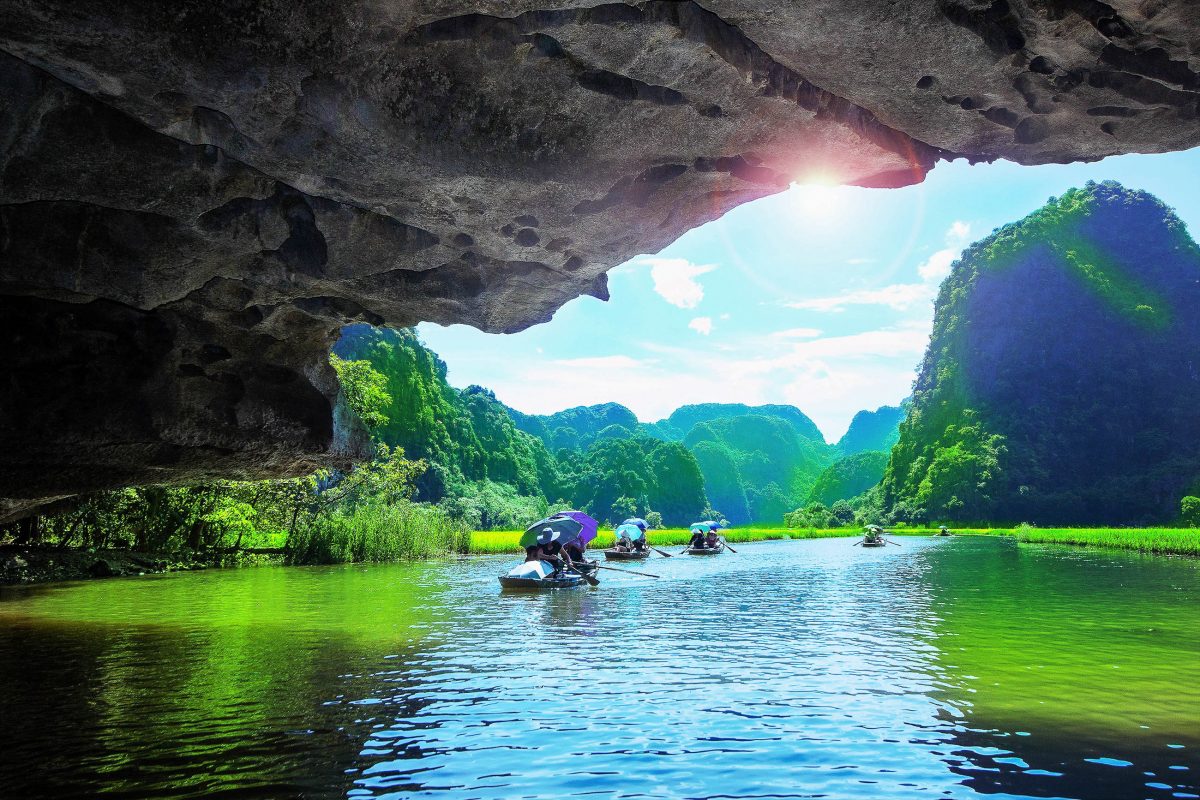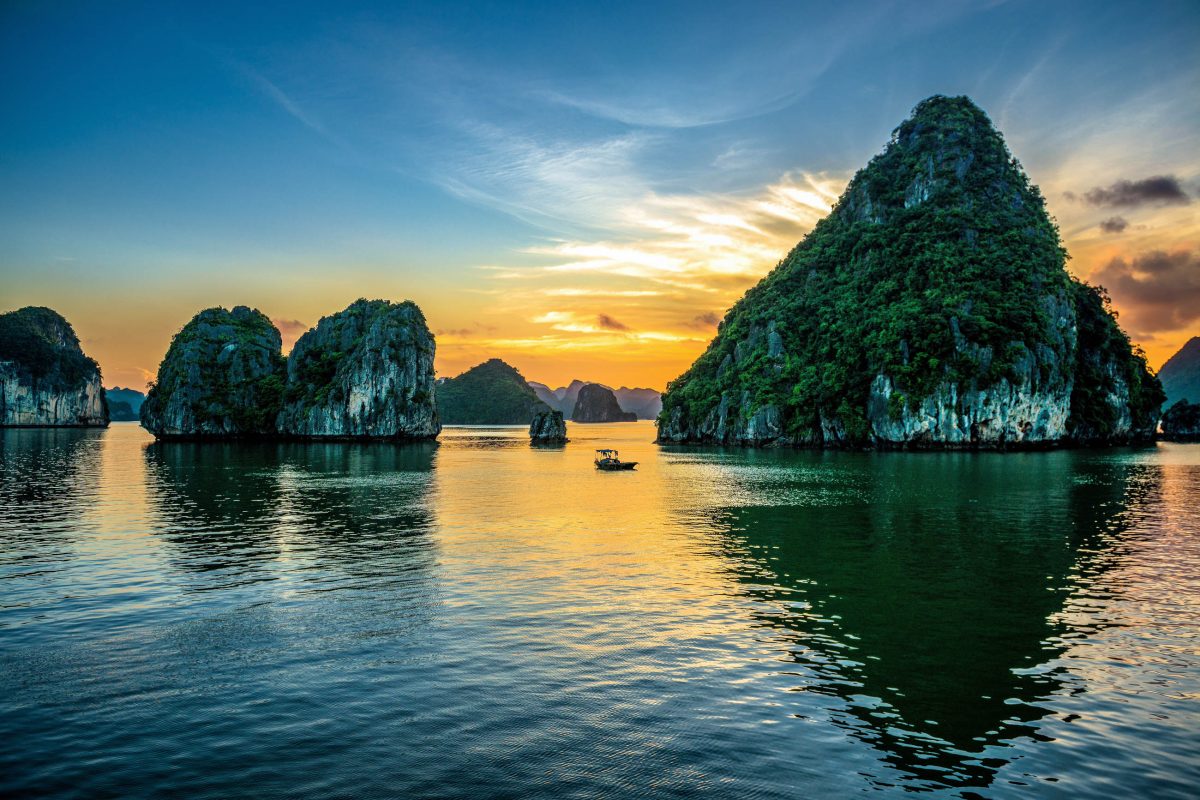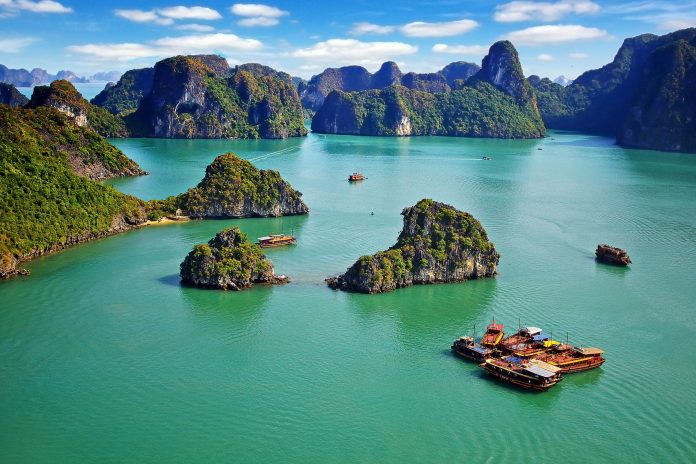In der Halong-Bucht im Norden Vietnams ragen entlang einer 120km langen Küstenlinie an die 2.000 spektakuläre Kalksteinfelsen in verschiedensten Größen und Formen aus dem Wasser. Neben der atemberaubenden Landschaft lockt die Halong-Bucht mit Höhlenbesichtigungen, Traumstränden und idyllischen Kanufahrten.
Die Halong-Bucht liegt im Golf von Tonkin im Norden Vietnams und ist ein absolut spektakuläres Stück Landschaft. Auf einer Fläche von etwa 1.500 Quadratkilometern ragen entlang der 120 Kilometer langen Küstenlinie an die 2.000 schroffe Kalksteininseln und -felsen in den verschiedensten Größen und Formen aus dem Wasser. Die höchste Erhebung beläuft sich auf 330 Meter. Seite 1994 zählt die Halong-Bucht mit 775 Felsinseln zum Weltnaturerbe der UNESCO.
Inhaltsverzeichnis
BILDER: Halong Bucht
Entstehung der Kalksteinfelsen in der Halong-Bucht
Vjnh Ha Long bedeutet „Bucht des untertauchenden Drachen“. Der Legende nach sollen die Götter eine Drachenfamilie gesandt haben, die den Vietnamesen helfen sollten, ihr junges Land gegen Eindringlinge zu verteidigen. Die Drachen spien Juwelen und Jade, die sich in der Halong-Bucht zu gewaltigen Felsen formten.
Einige der Felsen begruben die feindlichen Schiffe unter sich, andere tauchten unvermittelt vor den Booten auf, die daraufhin an den steilen Klippen zerschellten. Nach getaner Arbeit ließ sich der Mutterdrache in Halong nieder, seine Kinder zogen sich auf die Insel Bái Túr Long („Heimat der Drachenkinder“) zurück.
Tatsächlich entstanden die eindrucksvollen Felsformationen in der Halong-Bucht vor Millionen von Jahren durch einen gesunkenen Kegelkarst und waren zuvor über 500 Millionen Jahre der Erosion unter verschiedensten klimatischen Bedingungen ausgesetzt.
Einsame Paradiese der Halong-Bucht

Viele der Strände, Grotten und Höhlen stehen normalerweise unter Wasser und können nur bei Ebbe betreten werden. Einige der Höhlen sind dicht bewachsen, andere warten mit bizarren Stalagmiten und Stalaktiten auf.
Aufgrund der schweren Zugänglichkeit wurden die Inseln von den modernen Menschen bis jetzt so gut wie verschont. 14 Pflanzen- und 60 Tierarten leben nur auf den steinernen Felsen der Halong-Bucht. Funde in Bài Thơ Mout, der Đầu Gỗ Höhle und Bãi Cháy beweisen, dass die Inseln bereits vor 20.000 Jahren von Menschen besiedelt waren.
Vor allem die größeren Inseln, wie zum Beispiel die 354 Quadratkilometer umfassende Cát Bà, wurden während der Kriege gegen die Franzosen und Amerikaner als Flüchtlingslager, Nachschubdepot und Krankenhaus genutzt.
Heute wurde dort ein Nationalpark etabliert, Besucher erfreuen sich an den traumhaften Sandstränden. Die Insel lässt für Touristen außerdem nichts mehr zu wünschen übrig – Hotels, Restaurants und Bars reihen sich aneinander.
Unterwegs in der Halong-Bucht

Heute zählt die Halong-Bucht zu den beliebtesten Sehenswürdigkeiten Vietnams. Seine schroffen Klippen, verwinkelten Höhlen und eindrucksvollen Karstbögen machen eine Bootsfahrt zu einer unvergesslichen Reise.
Der Nachteil der großen Beliebtheit ist natürlich die Massenabfertigung der Touristen, doch ist man erst einmal einige Kilometer zwischen den spektakulären Felshügeln unterwegs gewesen, wird es langsam ruhiger und man kann die Idylle so richtig auskosten.
Neben dem eindrucksvollen Panorama kann man den Ausflug auch zum Trekken, Schwimmen, Höhlen besichtigen und Kanufahren zu entlegenen Stränden mit glasklarem Wasser nutzen.
Die schönste Höhle befindet sich auf Dau Go, Dau Be ist der beste Tipp für Schnorchler. Einige Tage in der Halong-Bucht unterwegs zu sein, lässt also bestimmt auch keine Langeweile aufkommen!

In den letzten zehn Jahren fielen immer wieder Schatten über die Halong-Bucht, als Touristenboote kenterten und sanken, im Zuge dessen sogar Menschen ums Leben kamen. Die mangelhaften Sicherheitsstandards und das hohe Alter der Boote wurden auch in den Medien oft aufs heftigste bekrittelt.
Tipp: Für Tickets werden teilweise horrende Preise verlangt, am besten zuerst etwas herumfragen oder direkt beim Hafen verhandeln. Viele der Inseln sind geschützt, doch die Einheimischen brechen immer noch Korallen und Stalagmiten ab, um sie als Briefbeschwerer, Schmuck oder Aschenbecher zu verkaufen. Beteiligen sich die Touristen weniger an dieser Geschäftemacherei, werden vielleicht auch die natürlichen Ressourcen der Halong-Bucht bald in Ruhe gelassen.
Weiterführende Links:
Offizielle Website der Halong Bucht mit Infos zu den einzelnen Inseln und Tourangeboten





